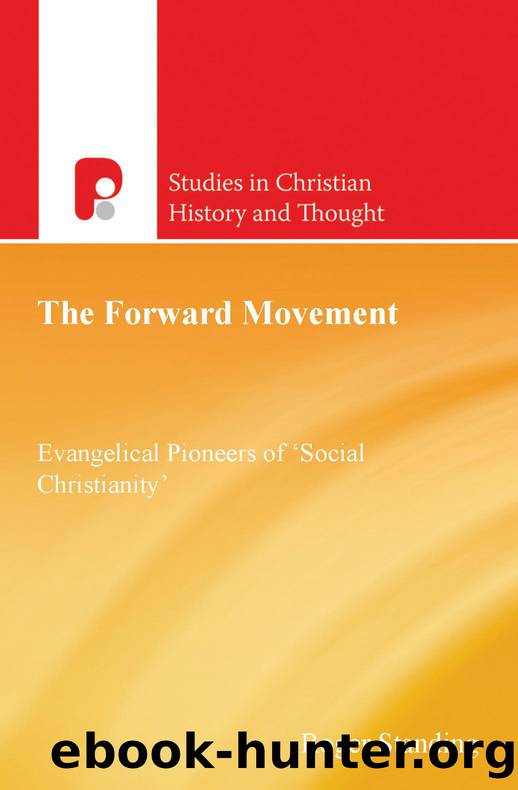The Forward Movement by Standing Roger;

Author:Standing, Roger;
Language: eng
Format: epub
Publisher: Authentic Media
Other Leaders: Further dimensions to the Movement
In the columns of The Methodist Times Hugh Price Hughes recognised other leaders within the Forward Movement who were not involved in establishing the Central Missions. They were following the ethos of the movement, but pioneering new forms of Christian service in other spheres.400
BOWMAN STEPHENSON had been converted in his teens at Dudley and having entered the ministry in the early 1860s soon came to the notice of his superiors. As a probationer minister in Norwich he took over a theatre for popular Sunday evening services much to the dislike of some within his congregation. 401 His next appointment in Manchester saw him undertaking a similar ministry, but this time falling under the criticism of the mill owners for during the Cotton Famine his radical politics led him to speak out in favour of âthe Yankeesâ.402 In Bolton (1865-68) he engaged women workers whom he styled âdeaconessesâ, who were especially significant as they formed the basis of his later work in the Childrenâs Home and the Wesley Deaconess Order which began in 1891.403
He was particularly influenced by the work of Immanuel Wichern in Hamburg, with his âRaue Hausâ for destitute boys.404 Therefore, it was only natural that as his next appointment in Lambeth brought him face to face with similar destitution amongst the young, that he should attempt a similar response. His âChildrenâs Homeâ was opened in 1869 and, following a visit to view Wichernâs work at Kaiserwerth in 1871, he began to explore more fully the use of women âSisters of the Childrenâ. The aims of the work were clear: âTo rescue children who, through the death or vice or extreme poverty of their parents, are in danger of falling into criminal ways ⦠to shelter, feed, clothe, educate, train to industrious habits, and, by Godâs blessing, lead to Christ.â405
In 1873 he was set apart from Circuit ministry to pursue the childrenâs work. He was also an advocate of temperance as well as the reform of Methodism for which he was a leader in the agitation for the inclusion of laymen at the Conference. He was an organiser of Moodyâs London campaign and never lost his evangelistic concern. He was elected to be the President of the Conference for 1891.406
W. FIDDIAN MOULTON also served as the President of the Conference, the year before Stephenson, in 1890. He was a scholar of note and had been involved in the revision of the New Testament. Turning his back on a chair of Theology he accepted the position of headmaster at the Leys School at Cambridge when it was opened in 1875 as a Methodist Public School.407
He had earned his reputation while a tutor at the ministerial training college at Richmond. It was there that he had first encountered Hugh Price Hughes and had defended him when Hughes had got into serious trouble with the authorities.408 A friendship developed between them in which Hughes viewed his old tutor as a counsellor whose advice could be trusted.
Download
This site does not store any files on its server. We only index and link to content provided by other sites. Please contact the content providers to delete copyright contents if any and email us, we'll remove relevant links or contents immediately.
Signature in the Cell: DNA and the Evidence for Intelligent Design by Stephen C. Meyer(2879)
Real Sex by Lauren F. Winner(2869)
The Holy Spirit by Billy Graham(2779)
The Secret Power of Speaking God's Word by Joyce Meyer(2755)
The Gnostic Gospels by Pagels Elaine(2400)
Jesus by Paul Johnson(2230)
Devil, The by Almond Philip C(2206)
23:27 by H. L. Roberts(2144)
The Nativity by Geza Vermes(2116)
Chosen by God by R. C. Sproul(2056)
All Things New by John Eldredge(2052)
Angels of God: The Bible, the Church and the Heavenly Hosts by Mike Aquilina(1870)
Angels by Billy Graham(1844)
The Return of the Gods by Erich von Daniken(1842)
Knowing God by J.I. Packer(1724)
Jesus of Nazareth by Joseph Ratzinger(1709)
Evidence of the Afterlife by Jeffrey Long(1705)
The Gnostic Gospel of St. Thomas by Tau Malachi(1680)
How To Be Born Again by Billy Graham(1670)
